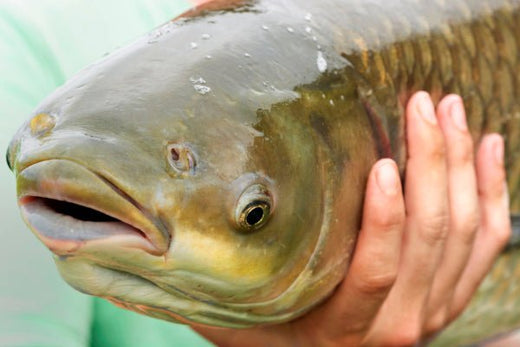Controlling Aquatic Plants With Grass Carp
Aquaculture ponds can be affected by excessive aquatic vegetation. In aquaculture ponds, the main problems are interference with fish harvest operations, nutrients that could have been more efficiently used by phytoplankton to produce dissolved oxygen, and reduction in water circulation which increases stratification and lowers levels of dissolved oxygen. The presence of too much aquatic vegetation in farm-ponds can interfere with hook and line harvest operations and increase the likelihood of stunted fish populations. It also reduces the aesthetic value and enjoyment of the pond as a swimming area and recreational pond. Both situations can be greatly benefited by grass carp.

GRASS CARPOLOGY
The white amur, also known as Grass Carp (Ctenopharyngodon Idella), is a species of carp that originated in Asia. The largest member of the minnow family (Cyprinidae), Grass carp is the Cyprinidae. Although they can weigh in excess of 110 pounds, they rarely exceed 35 pounds when kept in ponds. They live for 12-15 years, but most ponds need to be restocked within 7-8 years. The distinctive characteristics of grass carp distinguish them from other carp include their cylindrical bodies, terminal mouth (at its tip), lack of barbels (whiskers), lack of saw-toothed spines and lack of anal and dorsal fins with saw-toothed teeth.
The U.S. brought the first grass carp into the United States in 1963. Fish and Wildlife Service Fish Farming Experimental Station in Stuttgart Arkansas. These fish were imported from Malaysia and used to demonstrate the effectiveness of grass carp in controlling weeds in ponds and lakes with high levels of vegetation. Oklahoma allows grass carp to be stocked without a permit. However, some states require that grass carp be kept in sterile triploid form or are outlawed completely.
Grass carp are often considered an opportunistic feeder they will aggressively feed on plants. When water temperatures drop below 57 degrees F, grass carp activity and growth are greatly reduced. However, they will eat tougher plants as their food supply decreases. When pelleted fish rations are available, grass carp will readily consume them. Stocker fingerlings (8-10inches) can reach 5-7 lb during a growing season and 15-20 lb after three years, provided there is enough food.

STOCKING RATE
The desired control, vegetation type and density all affect the stocking rate. Complete vegetation elimination is the goal in most aquaculture situations. These ponds are shallow and nutrient-rich, so aquatic vegetation can quickly become nuisance. Stocking rates are usually high to ensure complete and rapid control. Stocking rates for grass carp fingerlings (from 8 to 12 inches) is typically 20 to 100 per acre. Actual numbers will vary depending on the number of plants, the density of the plants and the time it takes to get rid of them. With 20 grass carp per acre, most plants can be managed during the growing season. For ponds with Chara species, 40-60 grass carp are required per surface acre to quickly eliminate soft aquatic vegetation. You may need up to 100 grasscarp per surface acre. Grasscarp cannot control cattails and pond lilies, or other emergent vegetation. As preferred vegetation becomes less available, the grass carp eats more less palatable food which includes more woody, coarse-stemmed plants like smartweed and young cattails.
You can control filamentous alga with small grass carps of 2-4 inches. Stock 100 to 1000 fish per acre. This will reduce the amount of food available to each fish and also stunt them. This is good because grass carp can eat smaller amounts of filamentous algae. These fish can grow up to 8-12 inches in a single season, and then they can be sold to sport pond stocking markets for a slightly larger fish.
Because of the different objectives in vegetation control, stocking rates for sportfish tanks are usually lower than those for aquaculture ponds. The aquatic vegetation provides protection for young fish from predators in sportfish ponds. These plants can be eliminated completely, which could lead to a reduction in forage fish numbers and a decrease in largemouth bass population.

Small grass carp are extremely vulnerable to predation, and can be easily removed from ponds. Stock grass carp should be at least 8-12 inches long in order to ensure their survival in largemouth bass ponds. To avoid predation in ponds with large bass, grass carp should be at least 12 inches.
In ponds that are used to attract waterfowl, you should not have more than 2 to 3 grass carp per acre.
Sportfish ponds can be managed by grass carp if they are stocked at 5-10 fish per water surface acre and 15 fish per vegetated acres. After stocking the fish, this rate provides good control of vegetation for three years. The first year will show little change, but the second year will see more holes in the plant beds. To prevent complete aquatic plant eradication in sportfish lakes, it is best to remove vegetation slowly. Increase stocking density if you need to control vegetation faster.
The weeds can be eliminated by grass carp, which will reduce fishing quality and increase turbidity. Remove the fish until you achieve the desired level of vegetation control. You can catch grass carp by hook-and-line with fish feed, aquatic plants or dough balls. You can also shoot grass carp as they are feeding near shore. After stocking, Grass carp can control the vegetation for 7 to 8 years. They must be replaced after this period.
Buy Smith Creek Fish Farm Triploid Grass Carp Available Here

